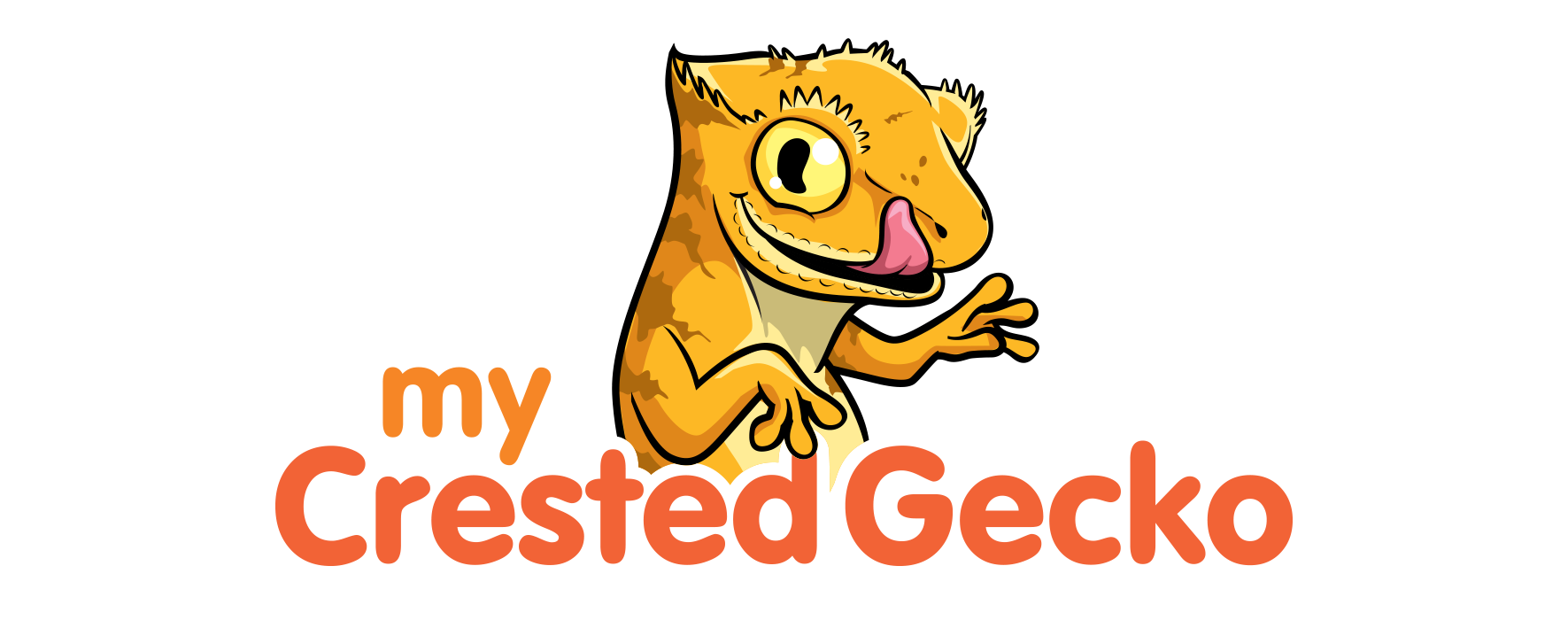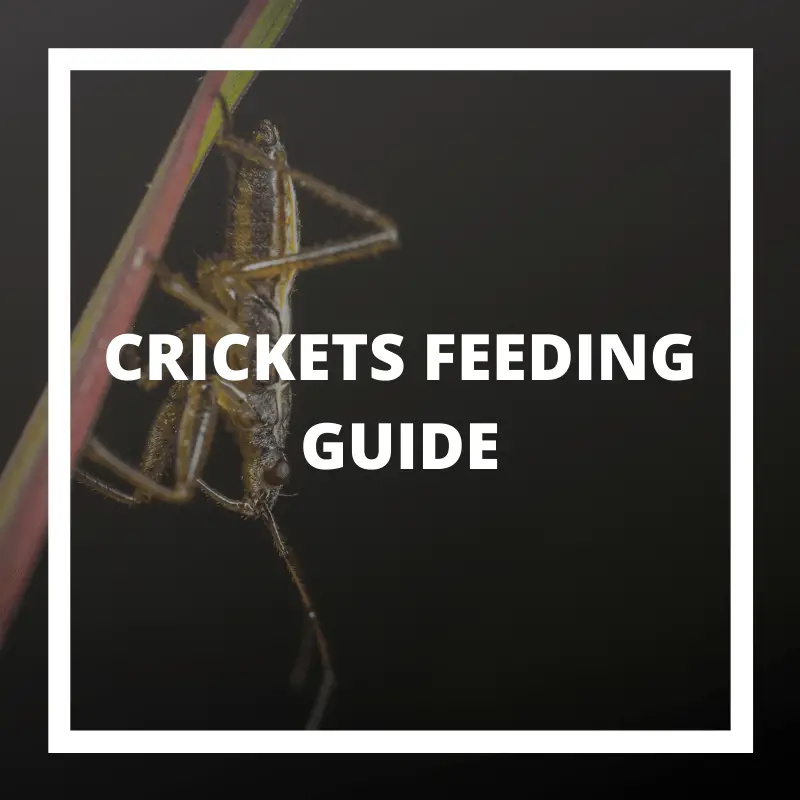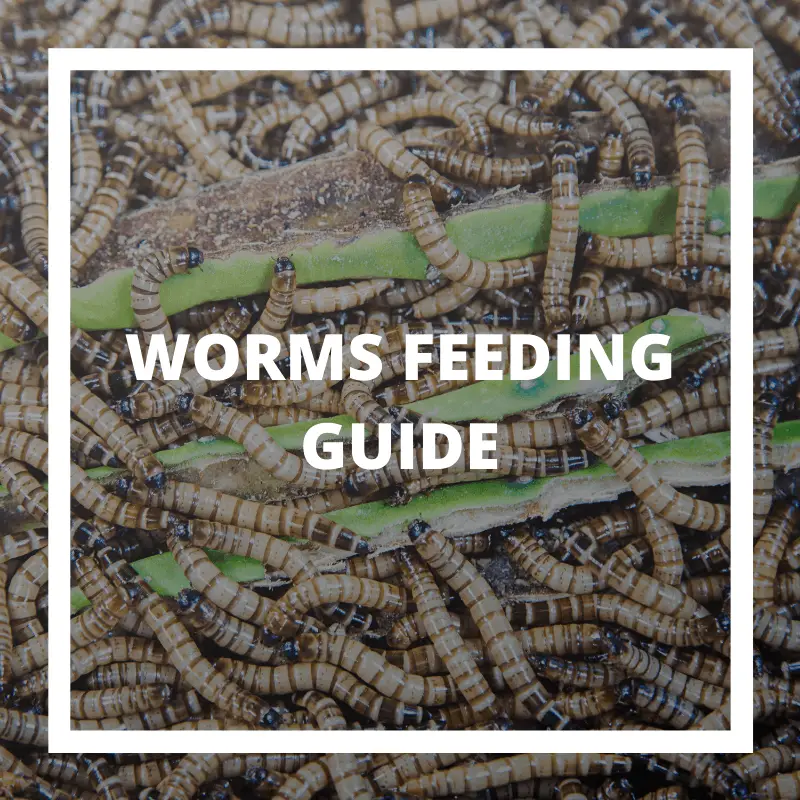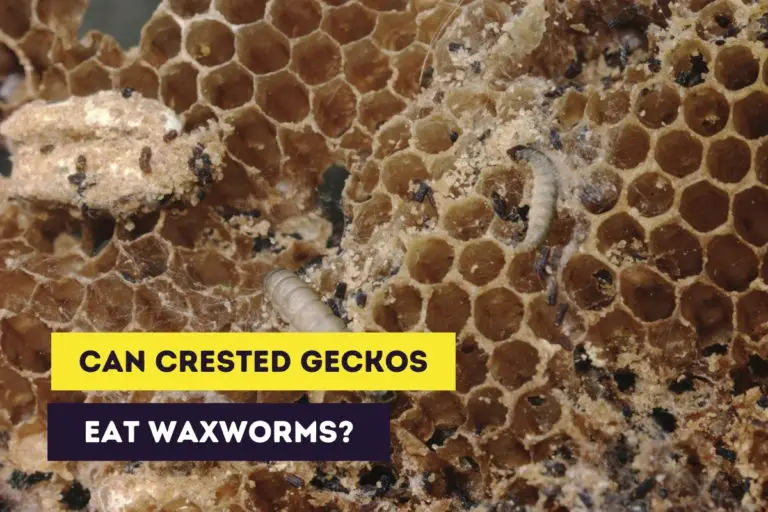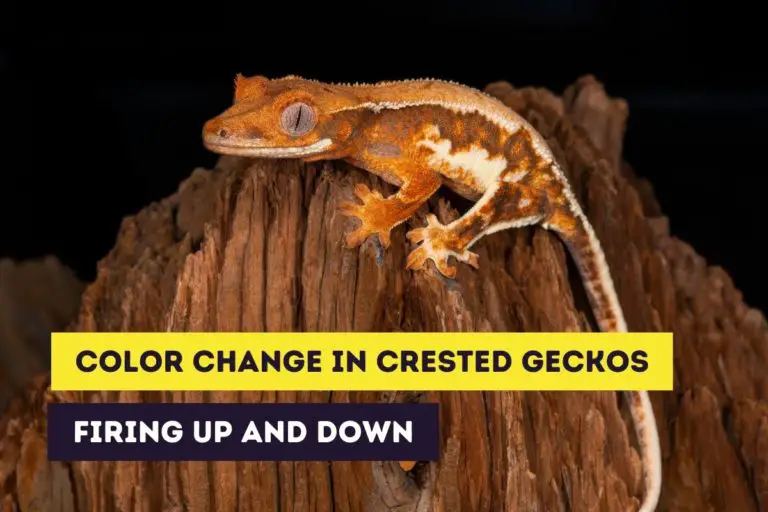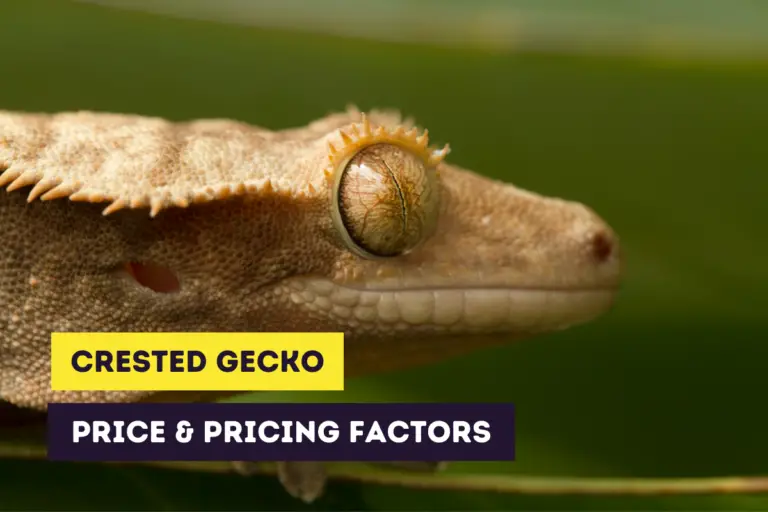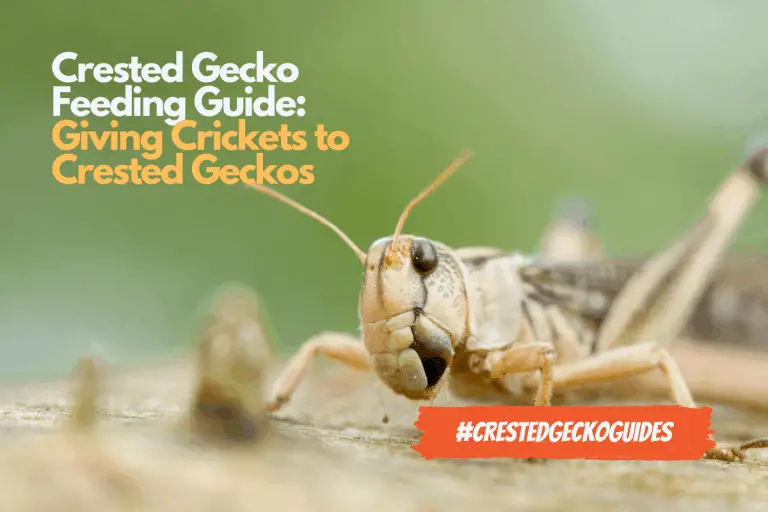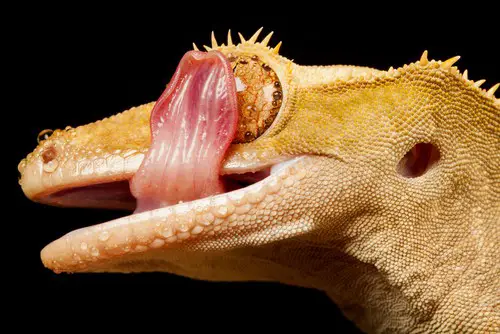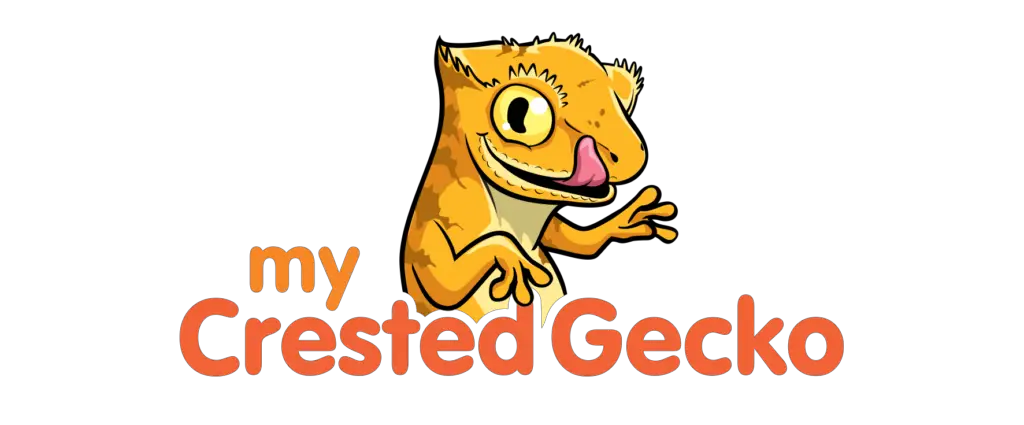Crested Gecko Diet Guide | Feeding Your Crested Gecko
Crested geckos are omnivores and – in the wild – will feed on insects, fruits, and the nectar of flowers they can find in their natural habitat. In captivity, the crested gecko isn’t very difficult to feed, also thanks to a wide variety of commercial crested gecko diets.
In short, a crested gecko diet should consist of:
- commercial crested gecko food (MRP)
- insects as a treat
- fruit and vegetables as a treat
- vitamin and mineral supplements (if necessary)
If you stick to their natural diet you can try and give a diet of gut-loaded en dusted insects and fruit. This will require a bit more planning and work from you.
More often, crested gecko owners – especially the ones that are new to crested gecko care – will benefit from commercial crested gecko diets and adding the occasional insect and piece of fruit.
If you’re interested in stickers or other products of crested geckos, you can always visit our Etsy Shop, which is called Artful Animalia. We currently only send stickers in the United States. If you’re interested in certain crested gecko-related products, don’t hesitate to contact us.
In this article, you’ll learn everything about the crested gecko diet. You’ll learn what crested geckos can and can’t eat in captivity and how to feed them. At the end of this article, you’ll know how to keep your crested gecko happy and healthy through their diet.
This site contains affiliate links to products we recommend and use ourselves. We may receive a commission for purchases that you make through these links. If you’re interested in learning more about our affiliate links, please visit our (affiliate) disclaimer.
The Crested Gecko Diet
A healthy diet is essential for the wellbeing and lifespan of your crested gecko. For the diet of your crested gecko, you can go two ways:
- an insect and fruit-based natural diet: this diet closely tries to mimic the diet of the crested gecko in its natural habitat. Crested geckos are omnivores but research has shown that most crested geckos have a diet based on fruit and nectar in the wild.
- a powder/granulate meal replacement diet: this diet takes the commercial available crested gecko food and tops it up by adding insects weekly and worms and fruit as a treat.
What’s the difference between these two diet approaches? Why don’t we just give the diet that the crested gecko has in the wild?
Well, such a diet requires you to measure and balance the different nutritional values (for example, the calcium/phosphorus ratio). The “natural” diet is not that suitable for new crested gecko owners.
The commercial crested gecko diet is easier and contains most of the nutrients your crested gecko needs to stay healthy. To provide extra vitamins and minerals you’ll need to gut-load and dust insects and worms and incorporate them in the diet. In this diet, you don’t need to give fruits to your crestie but it can’t hurt to give fruit as a treat.
Diet basics
Before you start feeding your crested gecko you’ll need to know what can be fed to your little lizard. Basically a crested gecko diet can consist of:
- crested gecko food
- insects and worms
- fruit
Crested gecko food (ready to go food)
Nowadays there are a lot of different reputable brands that have developed a commercial crested gecko food that provides about everything your crested gecko needs. There are two types of commercial crested food available:
- meal-replacement powders (MRP): this type of diet comes in a powder form which is then mixed with water into a paste. To give you an idea of how to make such a diet, you can find a detailed explanation below.
- granules/pellets: this type of diet comes in the form of little ball-shaped granules that can be put directly in the food dish. It’s as simple as that.
It can be difficult to find the right product for you and your crested gecko. If you want to learn more about all available crested gecko diets available you can read more about them in this article about commercial crested gecko diets (under construction).
How to make and use a meal replacement powder diet?
Get an MRP diet from the brand of your choice
Buy a meal replacement powder diet at your local pet store or online. There are a lot of decent online distributors of these kinds of diets. Make sure that the package is fresh and is not nearing the end of its shelf life.
Mix the powder and water
Mix one part powder and two to three parts water. The mix can look watery at this point but this is entirely normal.
Put the mix in a feeding container or feeding bottle
The mix should be put in a container or bottle and be left for a few minutes. The mix will become a thicker paste.
Put leftovers in the refrigerator
If you’ve got too much paste to feed in one serving you can refrigerate it and use it later. Most MRP can last seven days when refrigerated.
Feed your crested gecko
You can use feeding cups or a food bowl to feed your crested gecko. Feeding should be done in the evening.
Remove uneaten food within 24 hours
Your crested gecko might not eat all of the MRP. Leftovers should be removed as soon as possible and within 24 hours. This will prevent nasty smells and bacteria.
Popular brands:
Repashy: an established brand that offers a wide variety of MRP and supplements. It’s the first manufacturer of a complete meal replacement powder for crested geckos.
T-Rex: a seller that has a range of reptile products and also has its own MRP. They don’t have a lot of different MRP and might not be found in your local pet store.
Fluker’s Farms: a seller of a (tiny ball) granule diet that can be fed each day. The granules should be given in addition to insects to have a balanced diet. They also have an MRP product available.
Pangea: another well-known brand of MRP with a variety of tastes. Together with Repashy, this is the most known brand of crested gecko food.
Insects and worms
Crested geckos love to hunt insects and worms in the wild and in captivity. There are a few popular insects and worms that are part of most of the diets people give to their crested geckos.
The following insects can be given:
- crickets: the most popular choice of insect food for crested geckos. They’re a great source of protein and are also inexpensive to buy. The crickets should not be larger than the distance between the eyes of your gecko. You should also remember that you should only give as many crickets as your crestie can eat in one day. Crickets have a tendency to bite your crested gecko if left to roam around in the tank.
- dubia roaches: these roaches are rising in popularity among gecko owners because of their high nutritional value. If you want to feed them to your crestie you will have to make some effort because they’re not as easy to find in pet stores and are pricier than crickets.
Besides insects, worms are also often to feed crested geckos as a treat and shouldn’t be given as often as crickets. There are a lot of different types of worms available as food for crested geckos:
- mealworms: mealworms are the larvae of the mealworm beetle and are often used as food for fish, reptiles, and birds. You should be careful when feeding mealworms. They have a hard exoskeleton and can cause impaction. That’s why some authorities recommend not giving mealworms to crested geckos.
- waxworms: waxworms are the larvae of wax moths and are considered to be an excellent food for insect-eating birds and reptiles. Waxworms are safe to feed to your crested gecko: they don’t have a hard exoskeleton and won’t cause impaction.
- superworms: superworms are the larvae of the darkling beetle and are also known as king worms, morio worms or zophobas. This kind of worm is also often fed to reptiles, birds, and fish. They do have strong mandibles and can be dangerous for your crested gecko. It’s best to crush the head of the superworm before feeding it to your crestie.
If you would like to learn more about feeding insects and worms to your crested gecko, check one of the following guides by clicking the image:
Fruit
Crested geckos are omnivores but research has shown that they live mostly on a fruit-based diet in the wild. In captivity, most crested gecko owners will only give fruit to their crestie as a treat, limiting this to once or twice a month.
Crested geckos can eat soft fruit, with the exception of citrus fruit, that is high in calcium and low in phosphorus. The calcium to phosphorus ratio is important for your gecko’s health. It’s important that a crested gecko’s diet contains twice as much calcium as it does phosphorus. So the ratio should be 2:1.
Most fruits don’t have a high content of calcium but do contain a lot of phosphorus. Some fruits that you can give are papaya, figs, raspberries, prickly pears, berries, grapes, apples, pears, melons, watermelons, cherries, bananas, peaches, and cantaloupes.
Vitamins and mineral supplements
When offering insects and worms, you should be gut-loading and dusting them. You’ve probably heard those terms, but what do they mean?
- gut-Loading: This is the process of feeding the insects with extra nutrients 24 hours before you feed them to your gecko. Fluker’s High Calcium Cricket Powder is a popular choice for gut-loading
- dusting: This refers to coating the insects with calcium and vitamin D3 powder before feeding them to your gecko. It’s easy to do: just place the insects in a clear bag, add the powder, and shake the bag until they’re fully coated. Be sure to feed them to your gecko immediately so they don’t get chance to wash off the powder
Treats for crested geckos
Everybody loves to get some treats from time to time and crested geckos are no exception to this. But crested geckos, just like a lot of other pets, are given too much treats way too often. Since crested geckos can also get obese it’s important to limit the number of treats you give and try to give healthy treats.
The most common treats for crested geckos include mashed soft fruits like I already mentioned and worms because they’re high in fat content. Too much fat and phosphorus in the diet of your crested gecko will eventually lead to health issues. This is why you should limit giving these kinds of treats to once or twice a month.
Harmful foods
Baby food
Before there were any meal replacement powders, and even today, crested gecko owners sometimes used baby food to feed their crested geckos. A fruit-based baby food would replace fresh fruit but more often a mix of fruit and chicken or meat baby food was given.
The ratio that was recommended was about 4 to 5 parts of fruit and 1 part chicken or meat. The baby food needed to be supplemented with vitamins and calcium supplements. However, baby food often contains high amounts of sugar, additives, and preservatives that are bad for crested geckos.
So, although baby food was used often in the past as an integral part of a crested gecko diet, nowadays I wouldn’t recommend feeding it to your crested gecko. There are a lot of better alternatives available that were developed just for crested geckos.
Large insects
Insects are a good way to supplement your crested gecko’s diet, give them something to hunt for and keep busy. Your crested gecko will hunt and jump on the crickets and roaches but you should be careful that the insects are not too big for your gecko.
Make sure that you only feed insects that are large enough for your crestie. A good guideline is that the insect shouldn’t be larger than the space between a crested gecko’s eyes.
Citrus fruits
Citrus fruits are harmful to your crested gecko because of the citric acid in them. You should only ever give citrus fruits as treats, limiting giving them at most once a month, as a part of a well-balanced diet.
Water Requirements
Crested geckos in the wild live in a humid environment and need this high humidity and water to stay healthy.
Since crested geckos are unable to take a sip from a water bottle a water dish or water bowl is the only way to give your crested gecko water. Water dishes are available online and in stores. However, these dishes can sometimes be tipped over if they’re not heavy enough and eventually the dish will be filled with substrate, feces, and urine. You should refresh the water every day and clean the dish when doing so.
Although crested geckos will usually drink from the water dish, they will also get their water intake from licking the water droplets on leaves or on the side of the vivarium. Some crested geckos will even ignore the water dish and get their water from the water droplets. Make sure to mist the vivarium once or twice a day and that you mist the plants to create these water droplets.
Crested Gecko Feeding Schedule
How many times a week do you feed your crested gecko?
Adult crested geckos don’t need to eat every day and can go for a short period without food. A good feeding schedule will consist of feeding your crested gecko 3 times a week.
The exceptions to this general guideline are hatchlings and juveniles. To ensure that your little crestie grows up to a healthy adult, daily feeding is allowed.
A good schedule will consist of feeding:
- meal replacement powder or granulated food: every few days or 3 times a week
- insects: once or twice a week
- fruits and worms: once or twice a month
When to feed your crested gecko?
Crested geckos are crepuscular and nocturnal creatures and should be fed in the evening. The uneaten food should be removed after 24 hours to prevent the buildup of bacteria and to avoid nasty smells.
How much do you feed to your crested gecko?
It can be quite difficult to know how much to feed to your crested gecko. A lot depends on the size and age of your crestie. In general, a good guideline is the size/volume of the head of your crested gecko: only feed as much as the volume of their head.
How to feed your crested gecko?
Feeding your crested gecko is no rocket science:
- MRP or pellet food: place it in a shallow dish
- fruits: place them in the terrarium or in a shallow dish (when mashed up)
- insects: place them in a bowl, release them in the terrarium or in a separate tank to let your crested gecko hunt for them
Some example feeding schedules
You decide when you feed the meal replacement powder, pellet food, insects and soft fruit to your crested gecko but to give you an idea of some possible feeding schedules, you can find 3 examples below. The term crested gecko diet is a general term for meal replacement powder or the pellet/granulated food.
Example 1
| Day 1 | Day 2 | Day 3 | Day 4 | Day 5 | Day 6 | Day 7 | |
|---|---|---|---|---|---|---|---|
| Week 1 | CGD | CGD | CGD | Crickets | |||
| Week 2 | CGD | CGD | CGD | ||||
| Week 3 | CGD | CGD | CGD | Soft fruit | |||
| Week 4 | CGD | CGD | CGD |
Example 2
| Day 1 | Day 2 | Day 3 | Day 4 | Day 5 | Day 6 | Day 7 | |
|---|---|---|---|---|---|---|---|
| Week 1 | CGD | CGD | CGD | Crickets | |||
| Week 2 | CGD | CGD | CGD | ||||
| Week 3 | CGD | CGD | CGD | Crickets | |||
| Week 4 | CGD | CGD | CGD |
Example 3
| Day 1 | Day 2 | Day 3 | Day 4 | Day 5 | Day 6 | Day 7 | |
|---|---|---|---|---|---|---|---|
| Week 1 | CGD | CGD | CGD | ||||
| Week 2 | CGD | CGD | CGD | ||||
| Week 3 | CGD | CGD | CGD | ||||
| Week 4 | CGD | CGD | CGD |
Common Dietary Questions
Can crested gecko eat bananas?
Crested geckos can bananas. Bananas are soft fruits and can be given mashed up in a paste. You should only give small pieces of banana as a treat and only once or twice a month. Bananas are high in potassium which inhibits calcium absorption. The calcium-phosphorus ratio of bananas is low and giving too much is not recommended.
Can crested gecko eat mealworms?
Crested geckos can eat mealworms. However, mealworms do have hard exoskeletons. Feeding mealworms can, for this reason, cause impaction. I would recommend not feeding mealworms to your crested gecko or feeding only a limited amount of them. Waxworms are a better choice because of their softer skin. If you do give a mealworm, make sure to do so only once or twice a month and look for possible signs of impaction.
Can crested gecko eat apples?
Crested geckos can eat apples. Apples are harder fruits and can be given mashed up in a paste. You should only give small pieces of apple as a treat and only once or twice a month. The calcium-phosphorus ratio of apples is moderate.
Can crested gecko eat kiwi?
Crested geckos can eat kiwi but only as a treat. Kiwis are citrus fruits and are high in acids. Since citrus fruits should be avoided, it’s best to limit the amount you give and only give a piece of kiwi once or twice a month.
Can crested gecko eat applesauce?
Crested geckos can eat applesauce. Applesauce is easily palpable by crested geckos but does usually contain high amounts of sugar. If you give applesauce only give it as a treat and use unsweetened and low-sugar applesauce.
Can crested gecko eat grapes?
Crested geckos can eat grapes. Grapes are soft fruits and can be given mashed up in a paste. Grapes have a quite acceptable calcium/phosphorus ratio of about 1.4:1. This is not the best but also not the worst kind of fruit you can give.
Can crested gecko eat superworms?
Crested geckos can eat superworms. However, superworms have strong mandibles and can cause injuries when fed alive. It’s best to crush the head of the superworms before feeding them to your crested gecko. This will ensure that your crestie can safely enjoy its superworm. Superworms should be only given as a treat, once or twice a month.
Can crested gecko eat hornworms?
Crested geckos can eat hornworms. They’re not that well-known as a food source of crested geckos and look weirder than other worms. Some crested gecko owners report giving hornworms to their cresties without problems but others have had problems with the chemicals these worms can excrete (causing some chemical burn). If you want to be safe, I would recommend giving them safer waxworms.
Can crested gecko eat strawberries?
Crested geckos can eat strawberries. Strawberries are soft fruits and can be given mashed up in a paste. Strawberries have a calcium/phosphorus ratio of about 1:1.3. This is not the best but also not the worst kind of fruit you can give. Still, it’s best to limit strawberries and give it only as a treat.
Can crested gecko eat blueberries?
Crested geckos can eat blueberries. Blueberries are soft fruits and can be given mashed up in a paste. Strawberries have a calcium/phosphorus ratio of about 1:1.6. This is not the best but also not the worst kind of fruit you can give. Still, it’s best to limit blueberries and give it only as a treat.
Can crested gecko eat waxworms?
Crested geckos can eat waxworms. Waxworms are in fact the most popular type of worm to feed to crested geckos. They have soft skin and no hard exoskeleton like other worms such as the mealworm. Waxworms should be only given as a treat, once or twice a month.
Can crested gecko eat dubia roaches?
Crested geckos can eat dubia roaches and will love chasing them. Dubia roaches are a bit harder to find and are a bit pricier but is an excellent insect to alternate with feeding crickets.
Can crested gecko eat oranges?
Crested geckos can eat oranges but only as a treat. Oranges are citrus fruits and are high in acids. Since citrus fruits should be avoided, it’s best to limit the amount you give and only give a piece of orange once or twice a month.
Can crested gecko eat baby food?
Crested geckos shouldn’t eat baby food but when you do, for example as a treat, you should make sure that it’s baby food without additives and preservatives.
In recent years, the trend is to create food with no added sugar or less sugar. Baby food is no exception to this. You can find, if you look for it, baby food with no added sugar or low amounts of sugar.
My advice is to stick with meal replacement powders or pellet food that contains all nutrients your crested gecko needs and is developed for them. Don’t give baby food or only as a treat.
Want to Learn More?
If you want to learn more about crested geckos as pets, please read the following articles.
If you’re interested in getting crested geckos as pets you should also definitely read our article about baby and juvenile crested gecko care or (adult) crested gecko care.
